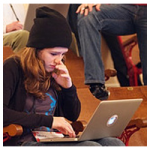‘student engagement’
Catch up on the Leading Lines Podcast
Apr. 13, 2022—The Leading Lines podcast team produced 3 new episodes in the last month that offer keen insights into digital and physical learning environments. Episode 107 – Mike Nino Miguel “Mike” Nino is the director of the Office of Online Learning at the University of North Carolina Pembroke. He spoke in this episode about the...
Pham and Cravens explore “What Students Value Most” in online degree programs
Feb. 8, 2022—By Cynthia J. Brame Associate professor of the practice in LPO Xiu Cravens and Vanderbilt doctoral alumnus Lam Pham recently published an analysis of student experiences in an online Ed.D. program, identifying key program characteristics and structures for promoting student engagement and satisfaction in a fully online program. Pham, who is currently an assistant professor...
Newly Updated Teaching Guide: Personal Devices in the Classroom
Dec. 16, 2021—The CFT first published a guide on considering how to work with wireless devices in the classroom in 2010. Given the rapidly changing digital landscape since then, this guide has been updated to consider how personal electronic devices (especially laptops) can impact learning in the classroom, and how faculty members may design policies and positions regarding their usage. ...
Teaching Innovations at Vanderbilt: Chad Carpenter and Multi-Step Class Problem Solving
Apr. 6, 2020—By Faith Rovenolt, CFT undergraduate intern During Spring 2020, the Teaching Innovations at Vanderbilt blog series will highlight teaching innovations that CFT staff have implemented and evaluated in their own courses. In teaching quantitative courses, it can be easy to fall into the trap of creating plug-and-chug problems for students. However, Chad Carpenter,...
Crowdsourcing ideas for student engagement and for dealing with student challenges
Oct. 1, 2019—by Cynthia J. Brame, CFT Associate Director One of the most persistent questions that faculty face is how to engage our students productively, both in and out of the classroom. In some settings this is easier than others: when students are taking elective courses in their area of interest, the road is often smoother than...
Big classes, name tents, and anxiety in the classroom
Aug. 28, 2019—by Cynthia J. Brame, CFT Associate Director Classes at my institution started last week, which means that my co-teacher and I greeted just over 150 students in our biochemistry class. When I start the semester, I’m always struck by how many students there are, and how a big class like this would not have brought...
Junior Faculty Spotlight: Sarah Suiter
Dec. 10, 2018—Each month, the CFT Newsletter highlights the work of our Junior Faculty Teaching Fellows. This month, Sarah Suiter, Human and Organizational Development, talks about her teaching philosophy and interests. I am faculty in the Human & Organizational Development Department at Peabody College, but my primary teaching responsibilities lie with the Community Development & Action master’s...
Listen to the latest Leading Lines podcast with Melissa Mallon
Mar. 13, 2018—In this episode, we feature an interview with one of our own. Melissa Mallon, director of the Peabody Library and director of liaison and instruction services here at Vanderbilt, has a new book out, and my Center for Teaching colleague Stacey Johnson had a lively conversation with Melissa about the book. Part of Melissa’s work...
Digital Polling in the Classroom: To BYOD or not to BYOD?
Jun. 21, 2016—by Jane Hirtle, CFT Graduate Teaching Fellow At the Center for Teaching we’ve been keeping a close eye on the rapidly changing world of classroom response systems. Where once there were few options, professors now have many choices both in terms of what kind of system to use and how to employ it as a...
Effective educational videos
Aug. 17, 2015—by Cynthia J. Brame Print Version Cite this guide: Brame, C.J. (2015). Effective educational videos. Retrieved [todaysdate] from http://cft.vanderbilt.edu/guides-sub-pages/effective-educational-videos/. Video has become an important part of higher education. It is integrated as part of traditional courses, serves as a cornerstone of many blended courses, and is often the main information delivery mechanism in MOOCs. Several...










